For the longest time, I’ve wondered about that odd little building at the corner of Commerce Street and Seventh Avenue South.
Shaped like a triangle, it occupies one of the weirdest plots of land in New York…
…and even has one of the few white picket fences in the city!
46 Seventh Ave South was a dry cleaning place until recently – now it’s up for lease, and being used as a storage space. But if you look in through the glass, you’ll see all these strange little details that suggest it has some sort of history. I’ve always wondered…
Then, out of the blue, the answer came last week when I received an e-mail from a West Village resident who had been wondering the same thing. He happened to ask his barber, a long-time Village proprietor, who gave him a DVD copy of what has to be one of the worst movies I’ve ever seen: Forced Entry.
Forced Entry is an unbelievably bad porno flick made in 1973 about a Vietnam vet who works at a West Village gas station. Seriously disturbed after his stint in the war, he tricks female customers into revealing their addresses, then hunts them down, rapes them, and kills them. In the end, his own psychological trauma proves too unbearable, and he kills himself.
This movie is bad.
I don’t mean so bad it’s good, I mean so bad you may lose all faith in humanity after watching the first 20 minutes. It looks like it was shot through an ashtray, the sex scenes contain nothing remotely sexy or appealing on any level, and the only highlight comes at the end when our hero kills himself.
BUT!
As it turns out, Forced Entry has ONE minor redeeming aspect: one of the locations in the film happens to be the weird triangle building on Seventh Avenue South!
See the rear wall of the West Village gas station?
Look familiar?
Yep! Long before it became a strange one-story glass triangle, this plot of land was a gas station! And amazingly, much of it still remains today.
The former gas station is located just a few blocks down from the key-covered Greenwich Locksmith shop I wrote about recently, and I asked owner and long time Village resident Phil Mortillaro if he had any info on the place. He dug through his files and turned up this amazing picture of “Joe’s Friendly Service Mobil Station” in its heyday! Hopefully, some of you car buffs can determine the year…
Below, the same shot taken today. Note that the street lamp is in virtually the same location:
Amazingly, the little attendant’s booth still exists, though now surrounded by glass. In fact, it juts out above the roof line…
Originally, the Mobil Pegasus emblem was mounted here, along with a different style roof:
Below, how the facade originally looked in 1973…
And today, inside the glass walls:
Another look at the exterior from Forced Entry…
And in a picture taken a year later in 1974 by photographer Julie Rinaldini:
Meanwhile, as for the rear wall…
…It’s basically exactly as it was in 1973, save for a new paint job!
Ah, it was a different age when you could film a porno at a Mobil gas station AND clearly identify its logo on camera! More importantly, note the Cherry Lane Theatre sign behind our hero, also visible in the black and white picture above:
The Cherry Lane Theatre is still in existence around the corner on Commerce Street, one of Manhattan’s rare L-turn streets. The theater is located in a building dating back to 1817, when it was used as a farm silo, and debuted its first play in 1924.
Finally, one last clue that 46 Seventh Ave South was once a gas station remains. If you pay attention to the sidewalks around it, you’ll notice two significantly wide ramps at either end…
…which once allowed cars in to gas up:
Amazingly, the Mobil station was just one of three gas stations that used to be located at this intersection. Half a block down the street, Forced Entry reveals there was a Gulf Station…
Long gone, of course:
And across the street, a Texaco:
Now a parking garage:
And what’s inside the little attendant’s booth?
One of the smallest apartments in New York City! What would you pay in rent?
Coming up with information on any of these gas stations is next to impossible. I was told they all opened up around the 1930’s to service commuters leaving for Jersey via the newly constructed Holland Tunnel, and that they all closed around the same time in the early 80’s.
But if anyone has any further information on any of the Seventh Ave South gas stations, please leave a comment! Special thanks to my anonymous reader for recommending Forced Entry (don’t worry, I’d want to stay anonymous too!), and to Phil Mortillaro for providing this amazing photograph and additional info about the space.
Click on the below photo to see it in enormous full detail:
-SCOUT
UPDATE!
In addition to the car years being narrowed down in the comments to sometime between 1958-62, reader Matthew E. wrote in with some helpful information:
- Joe, of Joe’s Friendly Service Station, was a neighborhood fixture for many years. He lived across Seventh Avenue, and even after the gas station shut down would look after Commerce Street, sweep leaves, etc. He had a thick Austrian accent, was a concentration camp survivor, and I think he once told me he had been a circus performer in Europe.
- After the gas station closed down there was a fire in the small building and it was boarded up for many years before being renovated and becoming a series of mostly unsuccessful businesses.
- In 1983, Pee-wee Herman filmed a sketch here!

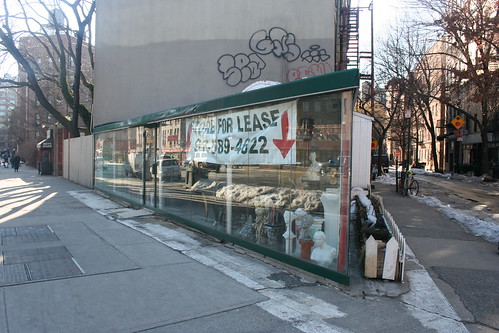
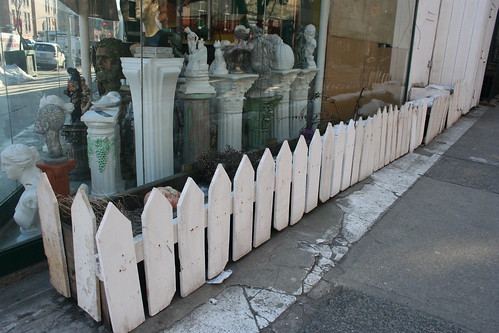
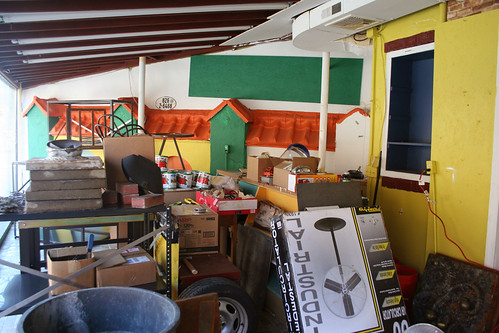
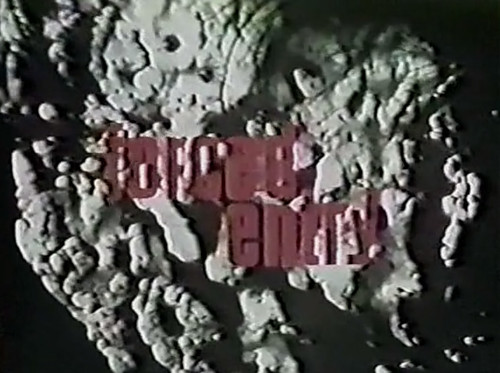

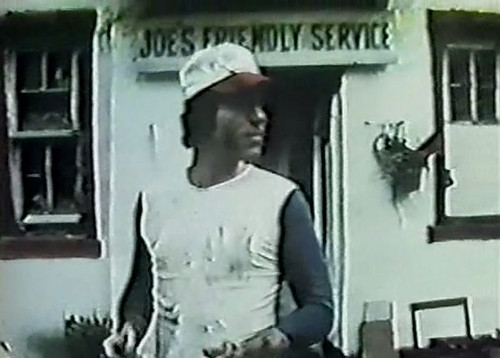

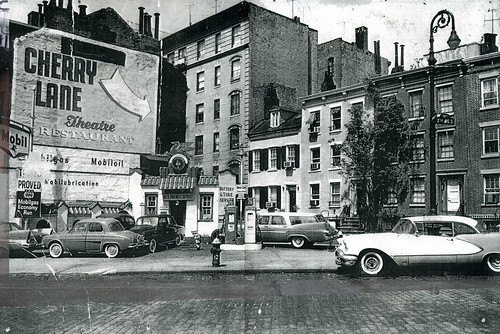
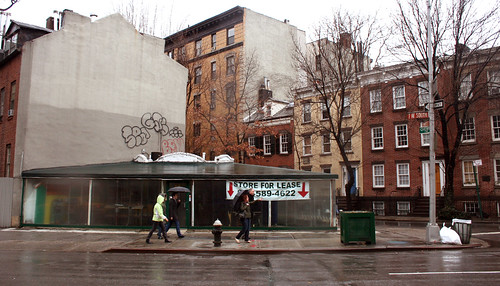
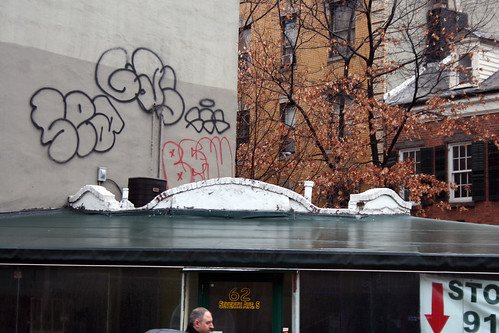

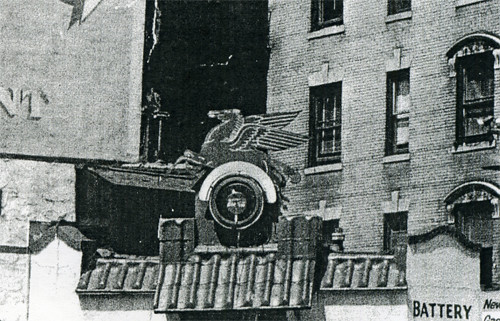
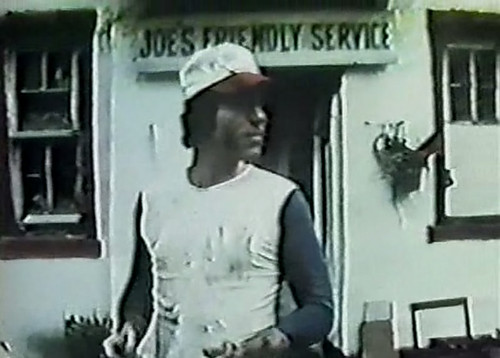
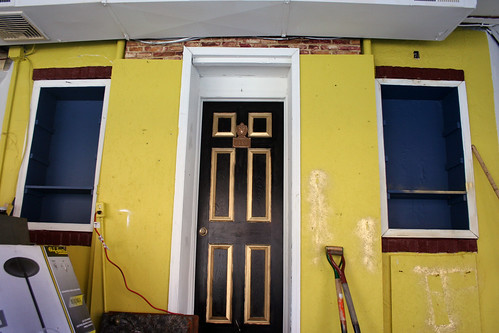

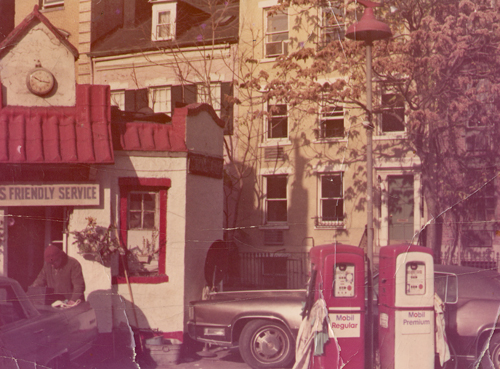
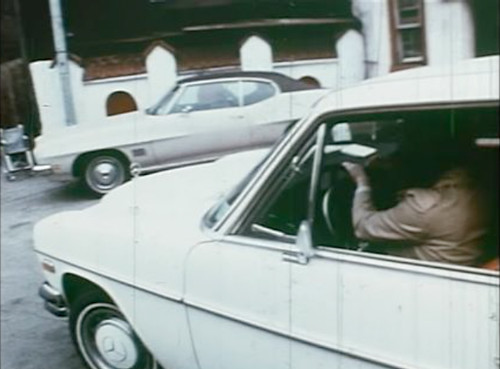


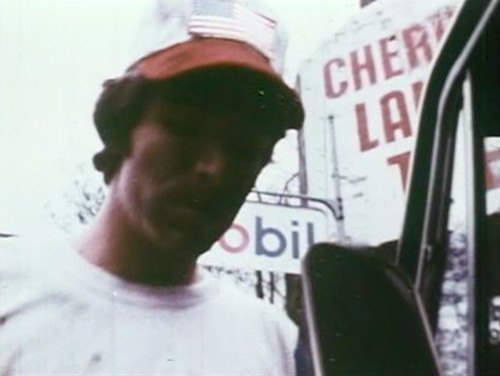
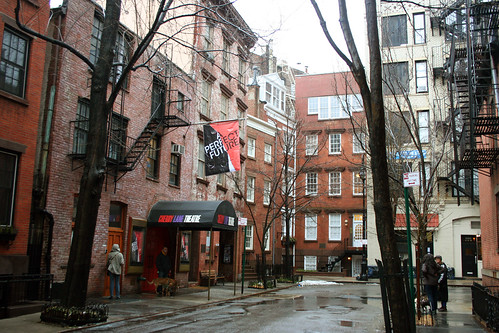
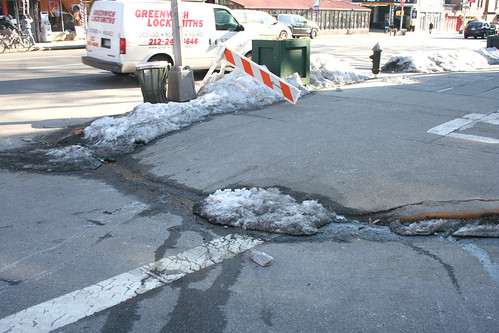
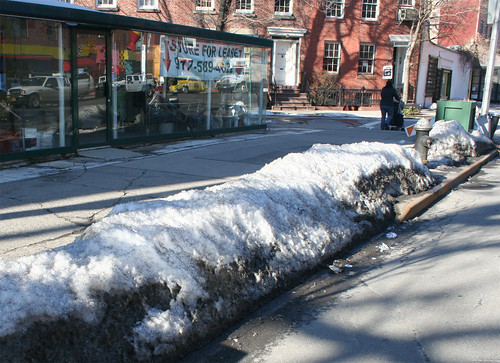
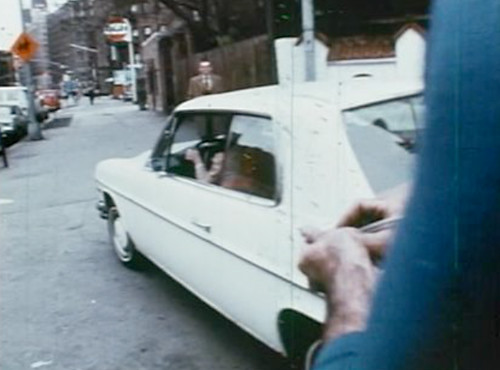
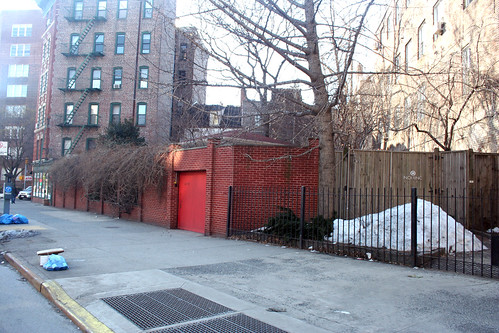
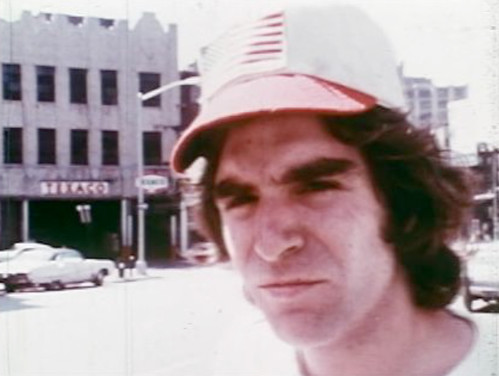
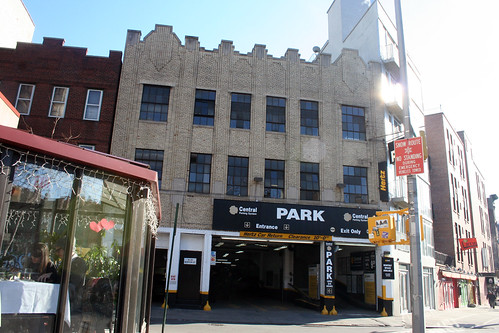
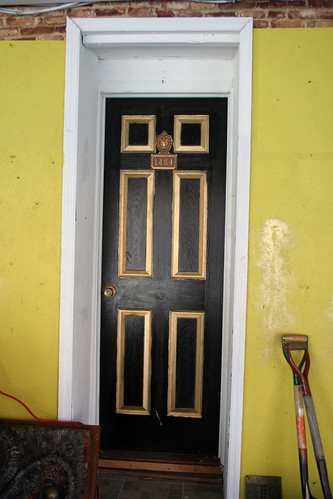
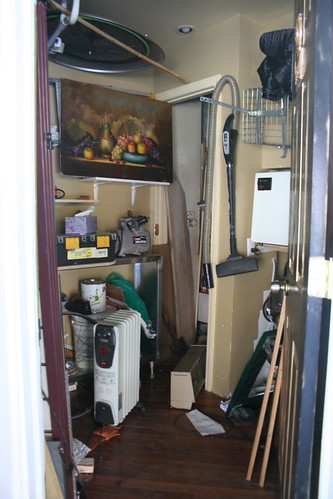
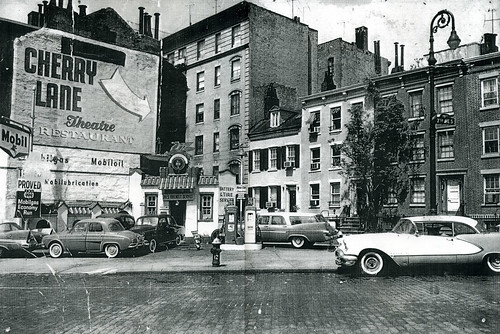

Thank you for giving me something new to read while I wait helplessly in the rain trying to get back to the city. I spend a lot of time in that neighborhood, and often wondered about that building that seems so out of place. Thanks for the info, now my night isn’t sooo bad!
Thank you for this post – so interesting (albeit quite depressing).
Sadly Cherry Lane is closing :*(
no doc, cherry lane is not closing…it will go on for ever! it is just in debt, and the owner is considering not selling it, but getting a great manager to help keep it rented, so that the debt can be repaid, and the artistic director can produce new american plays again! yay!!
The prices on the gas pumps are amusing. From the sign in the background of the pumps, looks like there is the regular pump and the “New Car” pump, for $0.249 and $0.289, respectively.
I was just wondering haw many gas stations were left in Manhattan?
Awesome stuff.
I’m wondering what is behind the red garage door and that low brick wall???
The Texaco gas station was an enclosed parking garage where many Village residents parked cars on a monthly basis for about $125 per month. There was much real estate that was held for lease after property values fell during the New York City fiscal crisis and investors held off on new development.
Always wondered about that place. Thanks for clearing it up!
Fantastic! Always one of my fave spots in the village! Thank you!!
Excellent work as always! I’ve walked by there a few times and only noticed the ugly little glass enclosure. Didn’t notice it was hiding a treasure!
Excellent post, full of detail and well illustrated: a fine example of what a good blog can achieve.
The Plymouth wagon behind the pumps in the B&W photo is a 1959 model.
I don’t know much about the gas station, but I lived in one of those brownstones in the background on Commerce Street at the time this movie was made. Wonder if my mom took me walking around the camera crew.
I suspect there will soon be an awkward conversation going on somewhere that starts with…”Uh, Dad, were you in a movie called ‘Forced Entry’?”
Yes Kelly! I know this is a super later reply but I thought the exact same thing. Haha. I wonder if that really happened…
wow, excellent info from my hood. In the 70s, the next block to the south contained Seventh Avenue South, one of the then best jazz clubs in the city. Owned by Randy and Michael Brecker (the latter who played tremendous jazz as well as some of the greatest pop solos of th e70s and 80s and 90s), the club hosted the hottest fusion and straight ahead of the 70s
Actually the price of regular gas on that sign is 34.9 cents – gas prices (at least in New York) had to be displayed as price / tax / total back then.
As far as when the picture was taken, I’ve narrowed it down to somewhere between late 1956 and 1962. The car at the left edge is a 1957 Plymouth Belvedere (new models were introduced in September of the prior year, so late ’56 is the earliest date). According to Wikipedia, Mobilgas and New Car Gasoline brands were rebranded as Mobil Regular and Mobil Premium in ’62.
And with focusfree’s ID of the ’59 Plymouth suburban we’re at late ’58 – ’62.
A bit more auto trivia … the car directly behind the Plymouth Belvedere is a rear-engined Renault, and the car perpendicular to it (right under the Joe’s Friendly Service sign) appears to be one too. These cars were never imported in significant numbers, so unless Joe collected Renaults the chances of seeing two of them in such close proximity are very very slim.
Excellent post, Scout. Loved it. Thank you *very* much.
Way to spoil the ending. Now there’s no point in watching this fine piece of cinema.
The car on the right is a 1956 Olds 88. Agreed on the Plymouth Belvedere.
excellent post. very enjoyable.
Has anyone tried contacting Mobil? Their PR department should have records… In the meantime, I’m waiting to hear back from the Cherry Lane Theater. According to the theater’s website, the restaurant advertised on the billboard was operating in the 1950’s. The original structure looks like it dates from the 1920’s Spanish Revival.
Last time I was in the area it was still a gas station. I am old and hate what has happened to the Village.
This is such a great post! I used to frequently walk past that place when it was a dry cleaners and always thinking it was such a bizarrely shaped piece of property too. Thanks for sharing all this information!
Hey Scout – great post. I’m in Dallas and we have a few vestiges of that model of Mobilgas station around here, too – mostly in ghetto neighborhoods and hacked into something gawd-awful like your glass triangle. But aren’t those little tile-roofed buildings beauties? I would definitely live in one if I could find one intact in a neighborhood where I wasn’t afraid to live. What a riot that would be!
BTW congrats on the fund-raising – good job boo! And the Sunday Morning! Woo hoo! <3 Congrats congrats congrats. You are now a star!
I think there used to be a crystal & gem shop in this spot? It was short-lived, and the walls were definitely made of poorly-insulated glass. My mom and I used to go there when I was a kid, early/mid 90s or thereabouts. Love it when your posts shed light on scenes from my childhood.
For Jen: It used to be a rock store that sold giant amethists and quartz and stuff. And when I was little I obviously collected rocks (I think because you can buy little ones at the museum of natural history for under $5, so that was all I could get with my spending limit whenever I went…. And I still have them). But anyway, I used to always go in there and just look at the big sparkly ones that I will never own because I do not collect rocks anymore.
amazing post!
In the 80’s, there was a restaurant next to the Texaco called Mexico Next To Texaco. My wife and I went there very late one New Years Eve in the mid-80’s because we thought we could still get food. The chef was gone, but the Mexican busboy went into the kitchen and cooked up some decent Mexican food for an enjoyable late night New Years Eve snack.
Brilliant post !
If this is the correct place, I believe that my husband and I recently purchased a ceramic dachshund statute here. The owner was a nice, but very interesting guy. He was newly in the space and it looks like he wasn’t able to stay.
The owner of the plot of land must have taken his cue from the glass-box architecture that has sprung up all over NYC. How else to explain this ugliness? I just clicked your link for the 1980s Pee-wee Herman short that was filmed at the defunct gas station, and it made me think that this wedge of space and its original structure would make a great little sidewalk cafe.
I could have done without seeing the Pee Wee Herman skit! lol But this history is cool.
We walk by this every day, and were thrilled to learn its history. Thanks for all you do!
Thank you for posting this. I love hearing history about NYC.
I’m wondering if Joe was selling Renault Dauphines back then. They were briefly popular in the late 50s – the second best selling import behind the VW Bug at one point – until they started falling apart and rusting with dreadful regularity.
Wow, another great post! I’m blown away by all the detailed information you find and the really entertaining way you share it. Keep it up.
Thank you. That was another fun post, one of many you have provided.
I have seen this movie. Its with Harry Reems, and yes you are right it is terrible! This place is down the block from what used to be the Now Bar,real tiny little place also.
Man, I remember that gas station. Sigh. Also, Larry “Bud” Melman is in that Pee Wee video.
The reason that the gas station structure itself has not been demolished is because it lies within the Greenwich Village Historic District and the Landmarks Preservation Commission would be loath to have it torn down without good reason.
In fact, I chair the Landmarks Committee of the local community board, and that glass structure came to us for approval around 2000. We recommended that it be built around the old service station and it was.
Btw, In the early 70s, NYC was home to a large porno film industry, during the Porno Chic era. However, just as they did sixty years earlier, when film makers left NYC for sunny California (DW Griffiths had a studio on 14th Street and Edison made quite a few shorts here, and some of the Little Rascals were shot over in Greenpoint), so too did the porno industry eventually immigrate to the west coast. Harry Reems, Ron Jeremy, Vanessa del Rio, Linda Lovelace, Gerald Damiano, and Al Goldstein were some of the NY natives who worked in the local industry back then.
I just looked up Forced Entry on the imdb and it wasn’t porn. It was just a low-budget stalk and stab movie. It starred Tanya Roberts. And that guy who someone said was Harry Reems was some guy named Ron Max. It also had Nancy Allen in it.
Ha, Bernie, I PROMISE you it’s a porn. The stabbing/Vietnam stuff makes up about 2% of the movie.
Bernie is confusing the 1975 Jim Sotos film with Shaun Costello’s 1971 (incorrectly listed as 1974 on IMDB) film.
While of course everyone is entitled to an opinion, bare in mind that Shaun made the film for well under $10,000 (that includes post) and that this was his first feature. He had previously only shot silent loops and, by his own admission, he was still very much an amateur.
However to dismiss FORCED ENTRY simply as ‘bad’ unfortunately speaks to a lack of historical context on your part. In 1970 and 1971, hardcore features were in their infancy and filmmakers from all backgrounds were experimenting with the concept of including explicit sex in their work, some much more successfully than others. Many directors of ‘mainstream’ feature films began their careers by making soft and hard X rated movies, among them John Avildsen and Wes Craven. People like Shaun, who had minimal formal training in filmmaking, fell into the world of X rated film production and discovered that their passions lay in the art of filmmaking. Although they were rarely supplied with the budgets, casts, or crews they needed to make GREAT movies, their passion for the art allowed them to craft off-beat, unique and sometimes genuinely fantastic works of outsider art in cinema. So, before you outrightly dismiss the film, please be aware of the artistic temperament of the era during which it was made.
Also, if you want to see what is arguably the consummate NYC X rated locations film, check out Armand Weston’s neo-noir, EXPOSE ME LOVELY.
The dark car behind the Renalut Dauphine is actually a Simca Aronde that was imported in very small qualtities. to the right of that is Morris Minor Tourer. The Renault in front was actually at one time in the late fifties the most popular imported car (after Volkswagen). The newest car to be seen is the Plymouth station wagon so my guess for the picture is 1959.
There are many of these triangular plots along Seventh Avenue South from when the avenue was blasted through many blocks of the village to build the Seventh Avenue subway south of 14th Street where Seventh Avenue ended orginally. You can also see oddly shaped buildings where sections of existing buildings were chopped off to make the right of way. Imagine doing that nowadays!
“and some of the Little Rascals were shot over in Greenpoint”
That’s an urban legend. Roach never operated a film studio in New York. He was in Hollywood since 1912, initially as a movie extra. He produced his first comedy shorts in 1915. The “Our Gang” shorts began in 1922.
As a lifelong resident of Greenpoint, I dug through countless photographs which were contemporary with the silent period of “Our Gang” production. Sorry to say, I have to agree with the info provided.
And just a few blocks up, in Agave Restaurant, the prize in your contest, the “Dog Day Afternoon” robbery was planned when it was known as “Danny’s Hideaway.” And years before that Agave was the location of a well known jazz club. Look up the address in the nyTimes archive.
You weren’t kidding when you said one of the smallest apartments in NYC was inside the building! Such a great historical find, too bad you had to suffer through such a horrendous movie to get the data.
Concerning the Renault Dauphine, it appears that a lot of cars of this type were exported from France in the late 50′. Renault wanted to challenge the WV’s beetle! They were brought from Le Havre to the port of NYC by Liberty ships transformed by Renault after word war II.
But before serching the web after reading this post, I was very surprised to see a Dauphine in NYC, because those cars were very typical of the 50’in France.
See this post (in french sorry!) discribing how the Dauphine arrived in the USA.
http://www.planeterenault.com/histoire2-29-La+Dauphine+aux+USA.html
Amazing post by the way, very interisting, even if you are very far from NYC like me. I thing it’s very important to keep “la mémoire des lieux”
We walked by today to check out the Locksmith next door. Turns out he’s currently using this space as a studio for his key art!
i think i belong in the 70’s back when cocaine and porno was totally normal.
Commenter Paul (March 4, 2011) correctly explains the oddly shaped lot. 7th Avenue South is known as “the cut.” The street was created quite literally by the cutting through of existing blocks/structures when the 7th Avenue subway was constructed. This left many small, triangular lots bordering the newly created road.
As late as 1994, there were another 3 triangular lots containing former or working gas stations nearby in addition to the Mobil, Gulf and Texaco stations noted. Since then, three small apartment buildings on the east side of 7th (at Morton; Carmine; and between Morton and Leroy) have risen on those lots.
The subject glass “building” is a brilliant squat. In the early 1990s, a man started selling rocks and crystals on the property. He gradually added cases to display his merchandise. With time, these cases became larger, more elaborate, and occupied a greater footprint until the installation of the glass walls and cheap roof were a fait accompli, albeit my recollection is that the rock merchant had moved on by that time in the early 2000s. And so, what had been a vacant lot with small structure at the perimeter came to be a “building.”
As for a “small apartment” from the original gas station structure — I saw the rock merchant on my early morning and late night walks with the hound. Indeed, it seemed he was never absent. It certainly appeared that he lived on the premises for the several years he was in operation.